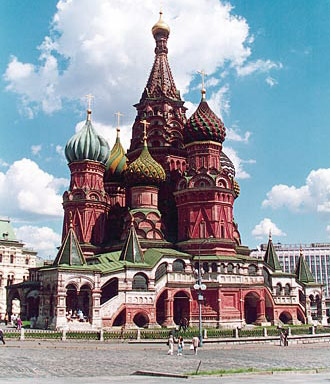
St. Basil’s Cathedral in Moscow, Russia was built by Ivan the Terrible between 1555 and 1561. According to legends, the builder of this Cathedral was blinded so that such a beautiful structure could never be built again. The Cathedral is vividly colorful and contains redbrick towers that add to its beauty. The church’s design consists of nine chapels, each mounted with its individual dome that marks the assault on the city of Kazan.
The Cathedral provides a strong religious symbolism and is based on architectural designs found in Jerusalem. Eight of the domes make a circular form around the ninth dome, forming a star (if viewed from the top). The number eight is considered an auspicious number according to Jewish calendar. There is a deep contrast between the interior and the exterior of the Cathedral. The interior contains modest decorations and is not that spectacular. The corridors inside are narrow and don’t have adequate space for worshippers seating.

Many times in history, the Cathedral has suffered damage due to violent communal incidents. If stories are to be true, the French ruler Napoleon wanted to take St. Basil back to France with him, but due to the lack of such technology, he ordered his army to destroy it so that no one else could occupy the church. His army had prepared to attack the church and had also lit up the gunpowder, but a mysterious rain shower prevented the explosions. These are legends, but people really believe in St. Basil’s mysterious powers and there are a lot of committed worshipers.
Although it's known to everyone as St. Basil's, this legendary building is officially called "The Cathedral of the Intercession of the Virgin by the Moat". The popular alternative refers to Basil the Blessed, a Muscovite 'holy fool' who was buried on the site (in the Trinity Cathedral that once stood here) a few years before the present building was erected.

The Cathedral was ordered by Ivan the Terrible to mark the 1552 capture of Kazan from Mongol forces. It was completed in 1560. That's pretty much all the genuine history that's known about this celebrated landmark. There, however, scores of legends. Nothing is known about the builders, Barma and Postnik Yakovlev, except their names and the dubious legend that Ivan had them blinded so that they could not create anything to compare. Historians unanimously state that this is nothing but urban folklore.
Architectural specialists are to this day unable to agree about the governing idea behind the structure. Either the creators were paying homage to the churches of Jerusalem, or, by building eight churches around a central ninth, they were representing the medieval symbol of the eight-pointed star. The original concept of the Cathedral of the Intercession has been hidden from us beneath layers of stylistic additions and new churches added to the main building. In fact, when built, the Cathedral was all white to match the white-stone Kremlin, and the onion domes were gold rather than multi-colored and patterned as they are today.

In the 17th century a hip-roofed bell tower was added, the gallery and staircases were covered with vaulted roofing, and the helmeted domes were replaced with decorated ones. In 1860 during rebuilding, the Cathedral was painted with a more complex and integrated design, and has remained unchanged since.
For a time in the Soviet Union, there was talk of demolishing St. Basil's - mainly because it hindered Stalin's plans for massed parades on Red Square. It was only saved thanks to the courage of the architect Pyotr Baranovsky. When ordered to prepare the building for demolition, he refused categorically, and sent the Kremlin an extremely blunt telegram. The Cathedral remained standing, and Baranovsky's conservation efforts earned him five years in prison.
The Cathedral is now a museum. During restoration work in the seventies a wooden spiral staircase was discovered within one of the walls. Visitors now take this route into the central church, with its extraordinary, soaring tented roof and a fine 16th Century iconostasis. You can also walk along the narrow, winding gallery, covered in beautiful patterned paintwork.
One service a year is held in the Cathedral, on the Day of Intercession in October.
Thank you :
http://en.wikipedia.org/wiki/Saint_Basil's_Cathedral
http://www.moscow.info/red-square/st-basils-cathedral.aspx
http://news.delees.com/general/st-basils-cathedral.html
http://www.sacred-destinations.com/russia/moscow-st-basil-cathedral
http://famouswonders.com/st-basils-cathedral-in-moscow/













